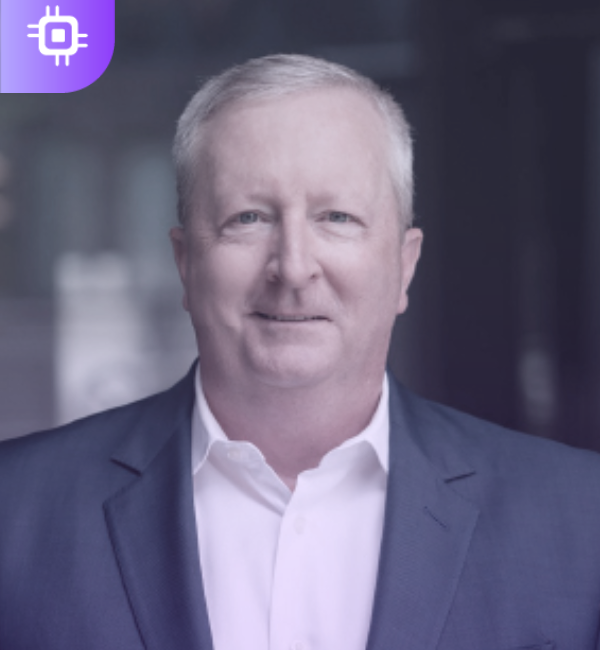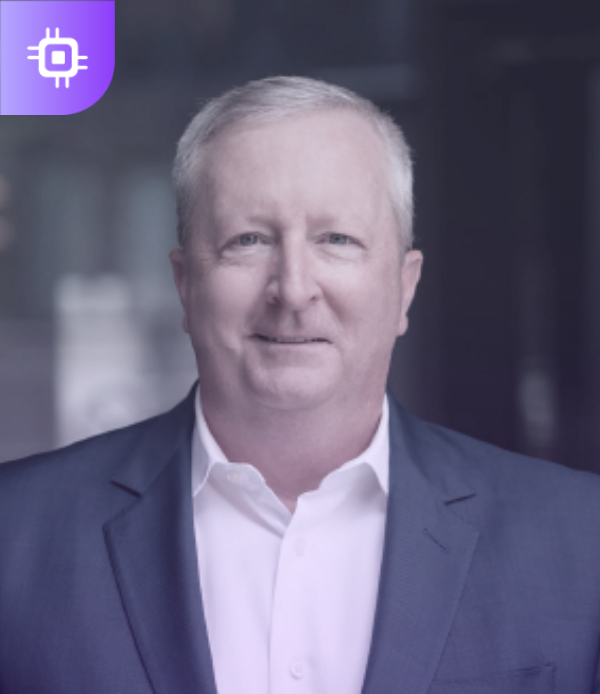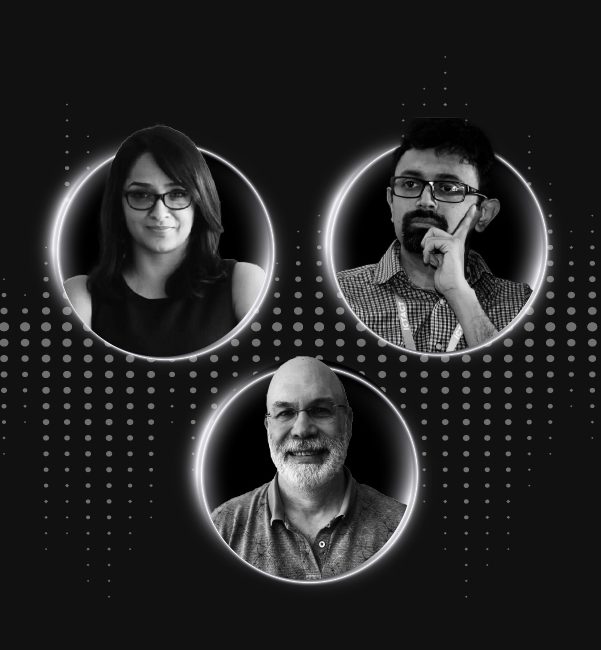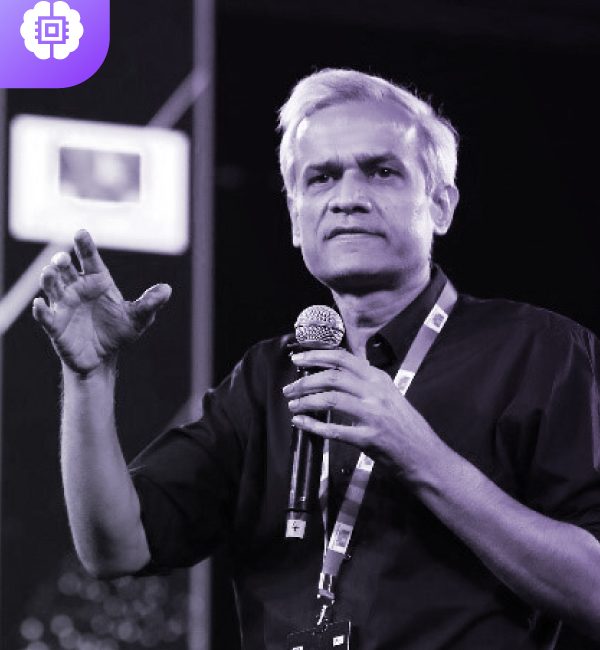
AI’s rise, from sidekick to center field. Guidance for CXO’s from Andy Walter, Sr VP IT (Retd), P&G.
About this Podcast:
A CIO leader’s notes on automation, digital transformation, and what it means to lead through change
Welcome to the second episode of The AI Transformation Podcast! In this episode, we sit down with Andy Walter, to discuss all things AI Transformation, automation, and leadership. Andy brings an arsenal of anecdotes and insights from his time at P&G and from his experience working with leaders across disruptive innovators in the industry.
Andy Walter is a business results-driven professional with extensive experience in strategy, development, execution, and operations across Global Shared Services, Analytics, and IT. He led the Commercial Services & Delivery Organization for Procter & Gamble’s Global Business Services (GBS), developing cutting-edge capabilities that helped P&G win where it mattered most! (Spoiler alert: We discuss one of these instances on the podcast!)
He has over 20 years of experience working on Boards and in Board level advisory roles. As a Strategic Advisor and Investor, he focuses on disruptive innovators in Digitization, Platform Models, and Advanced Analytics domains.
Andy has also authored the book, ‘Waiting is not action’ – A business leadership book for executives across industries with a focus on Disruptive Innovation, Strategy, and Career Development.
Listen on:
Episode Transcript:
Hey there! Welcome to the second episode of The AI Transformation Podcast! I’m Shyam, and I host this podcast with my founder, Ashwini Ashokan. At MSD, we've been bringing together leaders from across the world - CIOs, CEOs, digital transformation heads, CTOs, product and marketing leaders who have been crucial to transforming their businesses with AI. In this episode, CIO diaries with Andy Walter, we discuss all things AI Transformation, automation, and leadership. Andy Walter is a business results-driven professional with extensive experience in strategy, development, execution, and operations across Global Shared Services, Analytics, and IT. He led the Commercial Services & Delivery Organization for Procter & Gamble’s Global Business Services (GBS), developing cutting-edge capabilities that helped P&G win where it mattered most! (Spoiler alert: We discuss one of these instances on the podcast!) Andy brings an arsenal of anecdotes and insights from over 3 decades at P&G and from his experience working with leaders across disruptive innovators in the industry. How are business leaders approaching AI transformation and automation today? How can they successfully lead a transformation initiative? What has changed in the industry post-pandemic? We take a deep dive! Over to you, Ashwini!
Ashwini AsokanWelcome to the AI Transformation podcast, Andy. Thank you so much for taking the time to join us today.
Andy WalterThank you. Excited to be part of it.
Ashwini AsokanYeah, I've been waiting to do this one for a while now. Andy comes with a wealth of information and knowledge, having worked several decades across different types of industries, but also more importantly, more recently with CXOs and founding teams across the globe helping companies grow. And we are super excited to have Andy on board as an advisor to our company as well. In this podcast today, I'm hoping to cover a variety of topics. It would be completely amiss if we don't get to cover the breadth of things that Andy can contribute to this conversation here on all things AI, all things digital transformation, change management. There is so much going on in the market today, Andy. It feels like on one hand. It feels like everything is doomsday, and then, on the other hand, there's just the breakthrough of so many new possibilities, so much new technologies. You know, everything from the ChatGPT noise that we have in the market, there's just so much going on. Right. I just wanted to start off by asking you, Andy. What are some of the big changes that you are seeing over the course of the last 12 to 18 months, specifically as it relates to CIOs and chief digital transformation officers who are all obviously sitting up and going, “It's not just time for change, It's a little too late if you haven't started on that change,” But what are they doing and what are you seeing?
Andy WalterYeah, I mean, and you're absolutely right. I mean, we're at a really incredible inflection point right now. So. So what was happening like before the pandemic? You know, everyone was trying to get digital transformation going and they were getting limited success, limited attention from leadership, the ones that were, you know, then the pandemic hit, and they really accelerated their efforts. But your point - over the next 12 to 18 months. So what we see now is folks thought that was going to be a one time, once in a decade, black swan event. And now we've had a black swan event every single year, you know, So over the last 12 to 18 months, folks are dealing with incredible change and stress to all of their systems, their supply chain, all those type of things. So the CIOs and CDOs and really the executive leadership team now are really dealing with that, but at the same time realizing they can't slow down on their digital transformation, they can't slow down on - your point - looking at capabilities like A.I. that are not just going to transform every single business process they're working on, but they're literally going to create new business models that they've got to deal with and got to accelerate with. So so to your point, there's this is change is now become part of the strategy.
Ashwini AsokanYeah.
Andy WalterAnd black swans are now becoming part of the strategy as well. So it's not like we can just [say] “Okay, let's wait till this one calms down and we go back to whatever normal was,”. There is nothing like that.
Ashwini AsokanAnd as you say, you know, digital transformation strategies and they're on this journey and they've been in this journey for, I'm guessing, a couple of years now, right? And last 12 months in particular, Last six months in particular, just watching the buying cycles while on one hand you're seeing the slowdown of the market. On the other hand, you're you're almost seeing this like emergency, this urgent kind of.. call to action, Right? Of a particular kind. Like I can tell you that, you know, of all our products in our suite, the one that are getting the maximum attention are everything surrounding automation, cost saving, doing the same thing 10x faster. There's a bit of a theme we're seeing in the last six months with just just the shift in exactly what it is that people are asking for versus even before that, right? What are you seeing with very large enterprises? What are say, the 3 to 4 like top priority things that's on their mind in terms of actually implementing and seeing light of day.
Andy WalterYeah, well you've hit on a couple, but I'll stick with the top three. Number one is, first and foremost, winning with their consumer who's using their product. So we saw this incredible acceleration of direct to consumer selling and B2B, even B2B businesses going extremely online. You know, the sales teams were no longer kind of going out and meeting with clients. So, so much of that was driven by the content and your ability to serve that content in a perfect way for your consumer, whether that was a business or an individual buying their next dress or a business buying their next piece of software. So, that's the first one. Second you alluded to is automation. Folks are looking at every.. So I would say that three or four years ago folks would be looking at their business process and saying, okay, can I do some advanced analytics or some AI bespoke things over here to try to improve this business process? Now they're totally bringing them together. Now they're basically saying, how do I relook at my business processes and make AI and automation a core part of it, not just a little add on over here. So that's the second big one. And I think the the third big area as far as the priorities and digital transformation and things like that is is also around talent and and bringing the entire organization along on this journey.
Andy WalterI'll give you one great example. I'm on a board with Sandeep Delaney. He's now the CIO at UHC. He was the CIO of Mars during the pandemic. They had a companywide AI event. Every associate across Mars was invited to this AI event because they're trying to bring folks along in the journey. And then I'll tell you, as you alluded in kind of the at the beginning, I'm very fortunate now that I get to work across Incredible disruptive innovators like Mad Street Den and others. I get to do bespoke strategy work for a number of Fortune 500 companies. But then I get to work with an incredible group of C-suite leaders across the enterprise. The one thing that I'm seeing over and over again is the most successful ones, not only to think about talent inside their company, but they think about how do I work with the talent at these disruptive innovators? How does that become part of my core model? So, those are the three priorities that everyone is focusing on. And the ones that are winning are accelerating. They're not slowing down. You're right. There's all kinds of business pressures right now, all kinds of cost pressures. But the winners are are moving faster.
Ashwini AsokanWhat if I just take each of those threads - each of those three threads that you've brought up and dive in just a little bit on the consumer side that's there. Seems we are seeing a bit of a shift from customer acquisition strategies to very much around loyalty & LTV. It just feels like churn reduction. There seems to be a huge shift in the metrics of importance. But I would say, you know, 2021 felt like the year of growth at all costs, right? Like, “Go grab everybody you can, let's consolidate”. There's so many more strategies we saw going on in the market in terms of just being able to grow, you know, and beating competition. And now it feels almost like, every time we talk to a customer today versus like 18 months or 24 months ago, now, it's a story of like, how do I cross-sell? How do I upsell? How do I help them get the most out of my set of products that I have? How do I make sure they don't churn right? I think one of the questions, and we've seen this across FMCG We've seen this across like BFSI. Like, it doesn't matter the vertical you go after from a customer experience standpoint, it just feels like the theme of the day is how can I hold on to my guys, give them more value than I've ever given before, and then have them kind of coming back from a frequency engagement, LTV, kind of a perspective and setting that as, as the goal, right? Like, are you like, what are you seeing on the consumer side of things?
Andy Walter100%. You are right on. So I think the effect of having three black swans in a row - the pandemic, then the Ukraine war, and now a pending recession - potentially globally, has moved everyone from your point, growth at any cost to now profitable growth? How do I drive profitable growth for my business? And the way you do that in those direct-to-consumer businesses is exactly what you're saying. It's like, how do I win more of the dollar share or the wallet share of each of the consumers that I already have a relationship with, and it's critical. So again, it's like, how can I meet their needs better and reduce friction for them? Make it easy for them. That's what folks are really looking for. And I think that's going to continue to do it. But I keep coming back to this, though, also, because this is also true for B2B businesses they have got to do the exact same thing. And I think they're further behind in the direct consumer business is they need to be looking at these AI capabilities right now on on how can I better meet because churn to them is even more critical than a direct to consumer businesses. So I think we're going to see also that whole area. I'm starting to see it. The C-suite leaders and the traditional big, call it, ‘manufacturing’ businesses, B2B businesses, and even B2B software businesses are now saying, hey, we're behind; we need to get going on our digital transformation as well. But you hit the key. You hit the key thing completely. It's now about profitable growth and really understanding your consumer and how to serve her better.
Ashwini AsokanWhat are some technologies folks are deploying in that context, though?
Andy WalterWell, I think their content is becoming king again, you know, so but in a different way. It's how it's understanding the journey someone's going on with your content, you know. So, if I'm an online store, I want to know what are their attributes that what they're looking for, what is their taste, what is how do I better understand them so I can serve things up to them quicker. And you can no longer do this. Like when, when, when direct-to-consumer might have been in digital, might have been like less than 10% of your business folks would do this in a very manual way. You can't do that. You got to have automation. You've got to have AI running kind of in real time to be offering those things up. And then, you know, in the B2B space, the same thing, you know, it's content and understanding the journey of potential buyers going on, and an existing user is going on and make sure that we're meeting their needs, you know, and again, it's this thing is becoming such a critical mass that doing these things this is what I was right this is this is the mission of AI, of doing these tasks very fast and serving up just the right content at the right time.
Ashwini AsokanYeah. I mean, it feels like you're almost bringing up over there, and you're like two streams of takeaways there. I feel like one stream of takeaway is very much around data, right? With your conversation around like just the profile of the people and getting a higher resolution profile of the consumers or their attributes or the content that you're sending them and really questioning the effectiveness of, you know, are we doing the right thing by the people who are there? Right? So there seems to be a stream and a storyline there around just data. And I think that's a really interesting one. And we're in the business of all things data here at the company. And so much of what we're seeing on that data is… we keep joking in the company. About 12 months ago, yes, people were interested in tagging, content tagging, you know, product tagging. Just a higher level of resolution of the customer and the inventory and the process. People are interested, right? People will come in and sit down and then come back and tell us that's not a priority.
Ashwini AsokanLet's just double down on the personalization part of it, and let's just double down on, how do you go get me to convert all my new guys who are coming in, right? Like, we want new growth, new business, right, versus today. It's so funny. If you look at our funnel and our pipe, it's ‘tagging, tagging, tagging, tagging, tagging, tagging’. It's like 80% is about data collection, data organization, and just making sure that the data is of such a high quality, right? As opposed to, I almost feel like over the last decade, it was just a ‘catch all’, all right. Like big data - just go get any data you can get, right? It's all about, ‘Make sure it's getting recorded’. Nobody cared what to do with the data. It was just data that was coming in and piping into their systems. Versus today, people are sitting up and going, “Oh, how can I use this data? How can I make it richer? How can I derive insights from it?” And definitely feels like a shift in that. That feels like one stream of conversation there.
Andy WalterAshwini, to that point, data has now become material to the company. That's the shift that has just happened. And I'll give you a great example. Whirlpool, a large appliance manufacturer, the chief digital leader there, a gentleman named Röttgen, has basically helped the company realize that their valuation as a company has traditionally been very low.. 2 to 3 times revenue, you know, becoming a data-powered company, which now will drive all these appliances, new service models, new product selling models, all these types of things. They believe this can have a material impact to the company to grow to like ten times revenue because they become a data-powered company. So to your point, we've had this interesting shift where data has now become material to the company. Before, it was like, “Oh yeah, great, how do we collect our data, how we use our data, how we do these different things with..” and stuff like that. Now it's powering the engine of the company itself.
Ashwini AsokanThat's, that's a really interesting way to think about it, right? Like that. That data has gone from being something you collect to inform you to data becoming very material to how your company, like shareholder value valuation, like how, are people beginning to think about your company, which means it almost feels like, you know, all those statements around data as the new oil data, the new currency. I feel like it's fair to say from what you're saying and what we're observing here is that it's becoming more literal in some ways, right? It is the new currency because it is the more meaningful data you have that you can take decisions on. It feels almost like a competitive moat, right? Against everybody else.
Andy WalterYes.. And as such, there's another risk side of that, too. So I'm also a public board member and a private board member and things like that. And right now, obviously, if you lose control of your data from a privacy perspective that can have a material impact to your company, I think we're going to be getting into a place where it's like if you're not moving forward, and really figuring out how to drive your business with your data, you know, it's going to become a board level event where folks are going to be, “Wait a second, why are we so behind our competitors in this whole area?”, and so I think it's - I'm already starting to see it bubble up and become a board-level discussion, which is powerful.
Ashwini AsokanWhich is very powerful. I completely agree with that. And we're actually hoping that that allows for the digital transformation cycle to actually be like squished a little bit as opposed to what we saw in the last decade, which I almost feel like was painful to watch, just like the slow unraveling of plans as opposed to what you're seeing now, is just an acceleration of that old thing. The other stream and I don't want to also lose sight of the other stream you brought up around just automation becoming kind of important. What are ways in which you're seeing automation being implemented and executed?
Andy WalterWell, I mean, historically, folks have been doing automation in a lot of different ways, but it's been mimicking the way that humans were doing that business process and very rudimentary. And in all transparency, you know, the RPAs of the world broke pretty quick and didn't scale very well. I think we're starting to see a shift, and that is to this concept of an autonomous enterprise and autonomous business processes, where business processes can run and can adapt themselves based on events that are happening and things like that. You can't do that with RPA. That's got to be where AI is built into the business process and how the business processes run. And so when you think about an insurance company, how am I dealing with all of the claims and aspects of that? Perfect for that. If I'm a CPG company, I'm dealing with all the suppliers, all the retailers, all that interaction between them, all the cash to order, all those types of things. These processes are incredibly ripe to become autonomous enterprise applications. Autonomous enterprise processes. And most companies. Don't want what we've had. Also this - last ten years, we've had this revolution of the cloud. And what that's allowed companies to do is walk away from only dealing with giant, monolithic software solutions to now use best of breed. So as we think about this shift into the autonomous enterprise, they're going to want the same thing. They're going to want a platform, a capability that they can use across multiple business processes to accelerate this across their business. I know this is not a sales discussion on Mad Street Den and what you guys are doing. I'm in a very fortunate position to only work with the people I want to. And only work with people that I believe are going to be the disruptive innovators move forward in the way you guys approach some of these things makes that possible. That's why I want to work with you guys, and that's why I think there's going to be a key part of this thing.
Ashwini AsokanYeah, Yeah. And I think that point you made about automation being almost.. we've seen that wave of RPA, and we've seen what it's done. It did a lot.. for it almost feels like first-generation tech. You need people to be sitting down using these systems to create these roles, to create these bots, to be able to go do this. But there comes a point in that process where you go like, how long are you going to keep doing this? Right? At what point does automation become the norm, not the creation of these rules? Right. And for us, I guess at some level, a huge portion of our work in the market, whether it's in the insurance space, loans processing space, you know, KYC kind of documentation, all our focus has been like, “Hey, you should actually just have people deal with the exceptions”, right? That's the norm and having systems, and I think you use the word adapt. Having systems adapt to incoming data that it might not have seen before, but you have to use those contextual cues to understand what is actually going on and make a guess and then have it automate most of the paperwork and the processes and then have the humans kind of or learn, right? If somebody - the human in the loop is providing that feedback, that learning needs to be so much more real-time than it is today in the market. And so I can I can clearly see that as a huge area of operation.
Andy WalterAnd you brought up generative AI early in the conversation. Imagine my platform is able to give me recommendations on how to improve my business process itself.
Ashwini AsokanYes.
Andy WalterSo it's not only can adapt to change but where we're heading is the process will start, the capabilities will start telling me like, hey, you could do this more efficiently. Here's a recommendation of how we might optimize this, just like you're giving recommendations on direct-to-consumer. Yes, the platform could be giving recommendations on the business process. That's it's going to be a super exciting time.
Ashwini AsokanThat's right. That's right. I think that's exactly right, Andy. And I feel like we, I mean, obviously, we share the excitement. We wouldn't be in the business otherwise. But it's one of those things where, you know, on one hand, there's just the excitement that you're laying out just in terms of the momentum. Right. You're seeing so much change, so much new stuff coming in the market and people kind of I feel like we're also past this hype a little bit where people are while there is a lot of hype on ChatGPT and stuff like that; I'm looking at it purely through the lens of enterprise, The AI going, Oh my God, 2016 through 2020 was just like like everybody was doing 100 POCs at the same time, right? And it was just like millions of dollars being invested either in tools or point solutions. And there was a lot of trying and people going on with that hype as opposed to today, with Enterprise AI, where I'm beginning to see people who are coming at the table, coming to the table already seem to know what's going on. They know the systems. They've done some of this before. They've tried. They know where it fails, where it works and succeeds. I almost want to double down on this idea of change a little bit here, right? Everything about this AI transformation feels very much about change management. How have you seen some of the best companies deal with change? Because this is something that we sit down and talk with our clients.. we deal with Fortune 500, Fortune 1000, Fortune 2000 companies, and the name of the game is change management, right? Like you can bring the most conscious tech to the table but that means absolutely nothing if you don't know how to manage change or the company doesn't know how to manage change. Tell us a little bit about some of the success stories you've seen when it comes to change management.
Andy WalterYeah, change management is going to be everything. And you know, I talk about this a lot with executives I work with because it's all around influence, you know, the best leaders in the world do three things really well. They identify the big ideas they can sell into big ideas. They can convince people to go do this, and then they can execute the big ideas. And those last two, both on the influencing and selling in this idea and the execution, is where the change management is driven. And the three big things from change management from my perspective is - first and foremost, don't lose sight of where the value is created, and what happens with a lot of these big initiatives, big transformations, is folks lose sight of where the value is created, and it loses momentum. So you've got to stay so focused on how the value is created. Second is, you got to bring the senior leadership along, and a great approach I took. So when I led the analytics transformation at P&G, starting in 2010, we had about 30 presidents around the world. I found the 5 to 7 of them that really got it early and iterated this with them and got momentum with them. So don't try to fight every battle. Try to go where you can create real value fast with business leaders that want to iterate with you on this journey and make them successful. And some of the very top presidents at Procter and Gamble, we're walking around with their advanced analytics reports in their pocket on how they were winning with this thing, and that started expanding it across.
Andy WalterSo find those key leaders. Third - and this one I learned way later in my career is - don't go at this alone. Don't go at this alone. So you're obviously a successful CEO of a new business. You have an advisory board. You alluded to that. I tell every executive you need to have an advisory role. Your advisory board should be other executives inside your company, but it should also be thought leaders outside your company. You know, I'm right now on a digital transformation advisory board for a Fortune 500 company. The CEO of that company realized that he didn't want to just advisory board just to be people inside his company. He wanted to have one or two people that were outside of his company, also bringing transparency to how they were thinking about things and stuff like that. So, this is the network that becomes so critical on these change management journeys. And then there's all kinds of fun things you can do to you've got to. How do you communicate these things? You've got to paint the picture of a world. If we had this capability, what would the day in the life of our company look like if this was in place? And I'll give you a really fun example because it'll show my age, and you guys will be laughing at me. But back in literally 1998, there was this incredibly transformative new capability called the World Wide Web. And there were these two guys over an R&D that we're talking about how this was going to change the world.
Andy WalterAnd my boss said, “Hey, go, go talk with them and figure out what this thing is all about. But Andy, don't waste too much time on it. We've got other big projects we need you on”. I go back and I come back and tell my boss, “Hey, I apologize. I'm going to fail. This is big.” And they thought World Wide Web was going to transform how we could do innovation and knowledge management inside P&G. So, I installed the first World Wide Web server on my Windows 3.0 machine at P&G, there was no laptop… I mean, this was a tower, and built the first prototype of something that still exists today called Innovation Net that connected all 6000 researchers around the world. But Ashwini, how I sold it in, how I helped on the change management. Yeah, I created one sheet of paper ‘The day in the life of an R&D person if we had this capability’, that went all the way up to John Pepper, our CEO, who I presented to. And that's the end of the story. We executed this thing and drove it out across everyone. So you got to you've got to translate this into simple ways for people to understand and you've got to find those champions and then iterate with them. By the way, I'm still connected to John Pepper today, and he still remembers that meeting, which is really, really cool. And we've talked about it a couple of times, and I know he's.
Ashwini AsokanStill live for some of these stories on me.
Andy WalterAnd you know what? Yeah. What he basically said is and I came into the meeting assuming even though you were two years with the company. That you must know something about this, otherwise they wouldn't have you presenting to me. So literally, he came into this board-level meeting and sat right next down to me, next to me, like I was the only person in the room. And I became part of his advisory network on this journey.
Ashwini AsokanThat's fantastic. That's such a powerful story. But more importantly, you know, there are philosophical takeaways. There are practical takeaways, There are tactical takeaways. And I feel like the one from the one you just said, you know, writing out a piece of paper about the day in the life of someone and how that's going to truly change with it, you know, like the whole before or after. I think that's a really powerful way and a very simple but very powerful example of of how to bring about change. I almost want to wrap this up with the big kind of theme. In some ways, you know, that shows up every time you and I chat around leadership, right? Or also a leadership coach to all of these people that you're advisors to, that you're an advisor to and the folks whose board you sit on or actively kind of advise their business on growth. And I wanted to wrap the session up by asking, what are some of the most important themes you're seeing when it comes to leadership, especially through these turbulent times? What are some of the big ones for you, and what are you talking to people about?
Andy WalterYeah, no. And it connects to your last question around change management because.. what does good leadership look like right now? And who are the leaders that are really driving these transformations? And a lot of times I'll talk they really boil down to [this] - folks who are looking for three things from some individuals and really strong leaders do three things really well - One: first, they have a good strategy. They have a good vision for where they want to take, whether it's the transformation or if they're the CEO of a company or they want to take this thing, and they've got a strong strategy that people believe in. Second: People believe in them as an individual. They trust them. They believe they are a strong individual of strong character, and they want to follow them. So they believe in their strategy. They believe in them as a leader. The third one, and a lot of people miss this one, often is individuals who believe they(the leaders) have their best interests in mind as well. If you hit all three, if you have a great strategy, if you are a leader that people believe in an individual or human that people believe in, and you have their best interests in mind, they will run through that wall with you. And that's what that's what's driving these massive changes, because, in the end, you're right. It's funny because I'm a technologist by trade, and the technology is usually not the hard part. You know, it's the leadership. It's finding the leadership to really drive these things. So so that's the other thing I always look for is if I'm helping someone on their journey. You know, the thing we focus on the most is leadership. If you want to become a CIO, CTO, CDO, CEO, CMO, whatever it is, I can help you. But that's what we focus on.
Ashwini AsokanThat's fantastic.
Andy WalterAnd then what I look for when I look for these thought leaders, that's what I'm also betting on, is the leadership. You know, the leadership makes all the difference. So you're spot on.
Ashwini AsokanYeah. Yeah. And I mean, it almost feels like a theme now more than ever before. Not that, you know, there's not a dearth of books that have been written on the topic, but it's one of those things where these are turbulent times. And like you said, it doesn't feel like a one-time black swan event. It feels like a wave of these hitting us. And at some point there is a question around, have we shifted.. Are we at so much of an extreme on one end of that? That's a little bit. Of course, correction in some ways for the market, for the way we all work, for the way we think about work itself. Right, and to be able to manage every time we encounter as a company leadership teams that are in positions of decision making or we're going through that process and that journey with them to help company adopt their companies, adopt the AI. These are broadly the same set of questions that comes up. It doesn't matter what industry you're in. It doesn't matter what business you're in. It's a question of you having to adopt an AI. You're looking at change. The business is changing. How do you basically lead a very large organization through those times? Right. And what does that look like? And thank you so much, Andy. I think this was this was pretty fantastic. I think just in terms of the sheer scale of topics we ended up covering today. So thank you.
Andy WalterWe got a lot. Thank you. But thank you for inviting me to be part of it. Yeah, it was. It's fun. And like I said, these are we're at an incredible time right now for businesses, for technology capabilities, for AI now scaling and really making a huge difference. So it was fun being part of this with you.
Ashwini AsokanThat's wonderful. Awesome.
Shyam RavishankarThank you, Andy and Ashwini, for that insightful conversation. Andy, the notes from today’s podcast can fill up a book! Thank you so much for this goldmine of insights and the beautiful anecdotes you shared with us today. The key takeaways from the conversation are simply this: 1. A huge part of any transformation initiative depends on change management 2. It is not just about the technology - it’s also about the leadership, how leaders influence change and drive the strategy forward with a clear vision 3. Now is not just the time for transformation - it is already too late for the organizations that haven’t begun their journey yet That’s it from our end, I’ll see you next time around with more insights on another episode of the AI transformation podcast.
Meet your speakers:

Andy Walter
Board and Strategic advisor

Shyam Ravishankar
Manager - Digital & Content Marketing

Ashwini Asokan
Founder & CEO, Vue.ai







